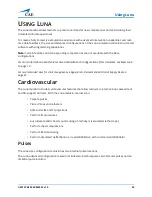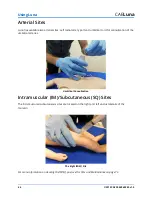
Using Luna
50
©2019 CAE 905K560252 v1.0
CAE
Luna
The following cautions should be observed:
• Defibrillation should be performed on the defibrillation electrodes only. If defibrillation is
performed over any ECG or pacing electrode, high voltage may be present on the
remaining connectors during the shock. This may also damage ECG and pacing circuitry.
• To prevent overheating, do NOT provide more than three (3) defibrillator discharges
(maximum 32 Joules) in a sequence. Do NOT exceed an average of two (2) defibrillator
discharges per minute during the training session.
• Do NOT let the manikin come in contact with electrically conductive surfaces or objects
during defibrillation. A flame-supporting atmosphere, for example, with a high content of
oxygen, should be avoided during defibrillation.
• Keep the manikin chest dry. Special attention should be taken when using the urinary
system or the chest tube feature.
DO NOT:
• Apply conductive gel or conductive defibrillation pads intended for patient use. This can
result in pitting of the chest skin electrode. Use cables or connectors with visible damage.
• Spill fluids over any component inside the manikin torso. This could damage the system
and may also present a possible hazard for the operator.
When using a commerical defibrillator, the ECG can be monitored via the defibrillator pads. Coarse
ventricular fibrillation and high-rate ventricular tachycardia cardiac rhythms are automatically
recognized as “shockable” rhythms.
With each defibrillation, the Maestro automatically records the amount of energy discharged and the
time defibrillation was performed. The simulated patient response to defibrillation is determined by
the scenario script or instructor intervention. Thus, cardioversion is not automatically determined by
the physiological models.
Luna is compatible with a wide variety of commerical defibrillators. SymDefib supports connections
to Physio-Control, Zoll and Philips.
CAUTION:
Do NOT allow defibrillator pads to come in contact with pacing disks or ECG nodes.
Defibrillating an ECG or pacing location will damage circuitry within the manikin.


































